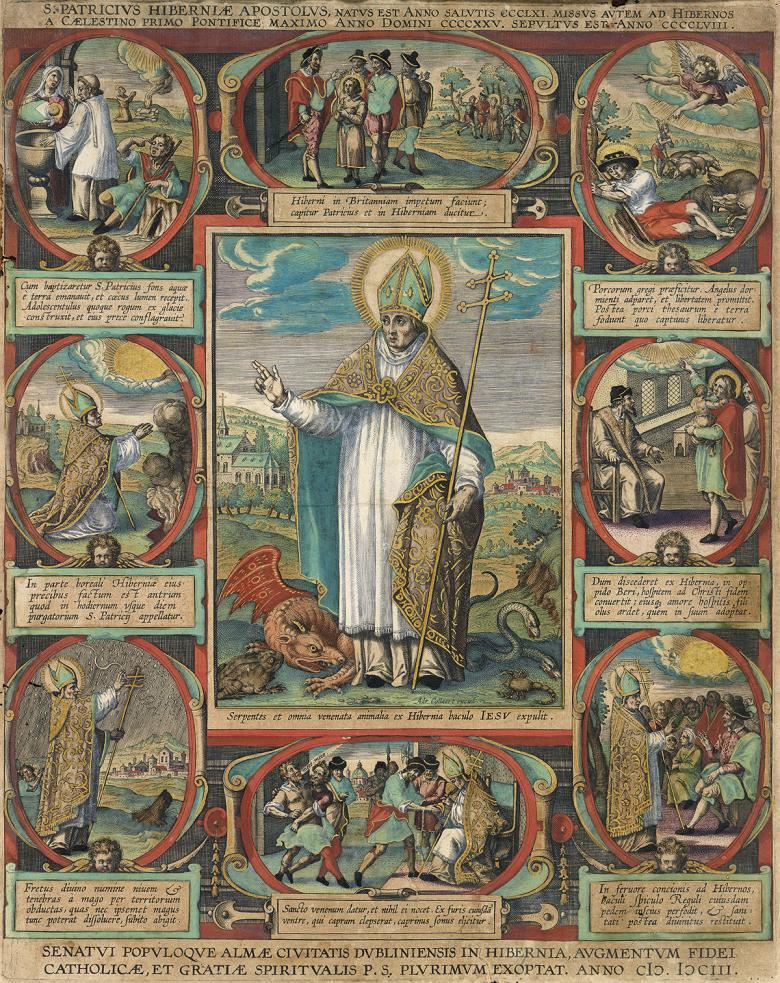The feast day of St. Patrick, March 17, is here again this year. St. Patrick is the patron saint of Ireland. Many Americans have Irish ancestry. For this reason, he is a popular saint in the United States.
Traditionally, three-leaf clovers (shamrocks) are used in decorations on St. Patrick’s Day. This is because, according to legend, Patrick used a three-leaf clover to explain to people about the Trinity, a mystery of God that is incomprehensible to the human mind. In fact, this story seems to have been invented in the 18th century. However, we can learn a little about the actual life of St. Patrick from his “Confessions” (meaning, his autobiography) and his “Letter to the Soldiers of the Coroticus”.
The Life of St. Patrick: his journey to becoming a missionary in Ireland
The dates of the birth and death of St. Patrick, who spread Christianity to Ireland, are unknown. It is believed that he was probably born in England in the late 4th or early 5th century. According to Patrick’s own recollections, he was the son of a Christian deacon, but was not a deeply religious man. The following is a brief account of Patrick’s journey to Ireland, where he was led to become a missionary.
Patrick was about 16 years old when an event occurred that would change his life forever. He was captured by Irish raiders, enslaved, and sold as a shepherd. Regarding his being placed in such a difficult situation, he wrote in his Confessions: “I deserved it because I had turned away from God and had not kept His commandments. I did not listen to the priests who advised me on how to be saved.” Being a shepherd in those days was a demanding job that constantly put one’s life in danger. Patrick continues that such an ordeal was not a punishment from God, but a blessing from God, who instilled in him more faith than he had had.
God’s Mysterious Guidance
His life in Ireland consisted of tending sheep and praying. One day, while he was sleeping, he heard a mysterious voice telling him that he would return to his homeland. Finally, the mysterious voice said, “Behold, your ship is ready.” And so, at the age of 23, Patrick traveled more than 200 miles, as a fugitive slave, to the landing place. When Patrick finally made it to the ship, the captain refused to let him aboard. Undeterred, Patrick prayed to God. Through God’s action, he was allowed to board the ship.
Three days later, Patrick and the other passengers got off the ship in England and began traveling through the wilderness. After 28 days in the wilderness, they finally ran out of food. The captain of the ship asked Patrick to pray to the all-powerful and great Christian God. Patrick prayed, and a herd of pigs appeared; Patrick and his companions killed the pigs, ate the pork, and regained their strength. Patrick also describes how he was attacked by demons that night and was saved by prayer.
In the past, travel in Ireland was safer by boat than by land. Patrick’s account of his wilderness journey is proof of the dangers and difficulties involved, which would be unthinkable today. It is unclear whether Patrick made it safely to his hometown or whether he gave up the journey and remained in a different place for a while.
France to Ireland
A few years later, Patrick was captured a second time. Finally, he escaped again and returned to his parents in England. However, due to his lack of education and his harsh experiences, he found it difficult to return to a normal life. Patrick felt a strong sense of mission from God and decided to go to Rome, even though his parents and relatives tried to stop him. On his way to Rome, he met St. Germanus. Patrick was to study for the priesthood under St. Germanus in Auxerre, Gaul (France).
It was during this time that he also received some mysterious guidance. He had a dream in which a man named Victoricus brought him countless letters from Ireland. With God’s guidance, Patrick decided to return to Ireland.
The rest of Patrick’s life is not from his own autobiography, but is a legend that has been passed down from generation to generation. What can be stated as historical fact is that Patrick introduced Christianity to Ireland, as well as the written word, the Roman calendar, and church traditions. The Christianity spread by Patrick took root throughout Ireland. After his death, Ireland became one of the most monasticized countries in the world, a storehouse of knowledge, and a training center for priests, monks, and nuns. Even monks and nuns from Rome came to study there.
A Strange Druidic Prophecy.
These stories are from the Life of St. Patrick by Muirchu, which was written about 150 years after Patrick’s death:
After arriving in Ireland, Patrick, who was now a bishop, went to Tara, which was ruled by a pagan king (the son of Nial) who had many Druids with him.
About two or three years before the arrival of Patrick, the Druids began prophesying to the king that someone was coming to their island who would try to destroy their way of life. The Druids’ prophecy, in poetic form (as was customary at the time), describes Patrick and Christianity with remarkable accuracy. It went like this:
The Druids’ Prophecy
A new way of life is about to come to Ireland from the outside.
It will be like a kingdom; it will come from far away across the seas;
It will bring an annoying teaching with it.
This teaching will be given out by a handful, yet received by many,
And it will be held in honor by all.
It will overthrow kingdoms, kill the kings who resist it,
And seduce the crowds.
It will destroy all our gods, and cast out our Druidic skills and works;
And this kingdom will have no end.
One with shaven head will come here with his curled-headed stick.
He will sing foul things from his home with perforated head.
From his table in the front part of his house,
His whole family will reply to him, “Let it be, let it be!”
Is the Druidic prophecy real?
I love myths, legends, and folk tales. One reason for this is that some of the tales passed down to us are based on fact, albeit adapted or exaggerated.
The ancient Druids were famous for sacrificing human beings in a cruel manner and for being able to foretell the future. Clearly, the Druids practiced a satanic religion. If the Druids’ prophecies were made with the help of demonic forces, it would explain why the content of those prophecies sometimes reminds me of the stories of demons who do not want to (or cannot) describe holy things, and who use the names of everyday objects to describe them.
In William Caxton’s translation of The Golden Legend, there is a story about an exorcist’s chalice, which the devil calls a “pot.” Of course, the stories in The Golden Legend are not always historically true, but it seems to me that all the descriptions of holy things in the Druidic prophecies are quite similar, using the names of everyday objects.
Exorcist Fr. Vincent Lampert stated in one interview that demons avoid talking about holy things. The Druidic prophecy describes a Catholic bishop with a shaved head and a staff, but it does so indirectly. And the final “may it be so” is a translation of the Hebrew word “Amen.”
Although this story may have been invented later, I think it is a very interesting prophecy because of the cultural background of Ireland at that time.
Continued in part two.
Image: Scenes from the Life of Saint Patrick. National Gallery of Ireland
Source for the life of Patrick: Celtic Spirituality. Oliver Davies : PaulistPress, 1999.

